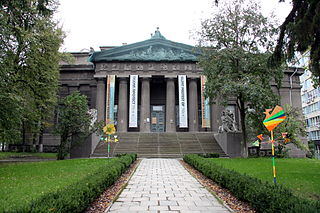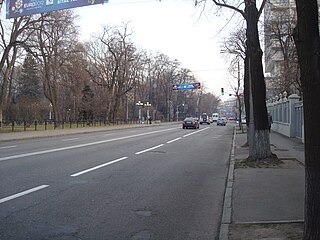
Kiev or Kyiv is the capital and most populous city of Ukraine, located in the north-central part of the country on the Dnieper. The population in July 2015 was 2,887,974, making Kiev the 7th most populous city in Europe.

Saint Sophia Cathedral in Kiev is an outstanding architectural monument of Kievan Rus'. The cathedral is one of the city's best known landmarks and the first heritage site in Ukraine to be inscribed on the World Heritage List along with the Kiev Cave Monastery complex. Aside from its main building, the cathedral includes an ensemble of supporting structures such as a bell tower and the House of Metropolitan. In 2011 the historic site was reassigned from the jurisdiction of the Ministry of Regional Development of Ukraine to the Ministry of Culture of Ukraine. One of the reasons for the move was that both Saint Sophia Cathedral and Kiev Pechersk Lavra are recognized by the UNESCO World Heritage Program as one complex, while in Ukraine the two were governed by different government entities.

Football Club Arsenal Kyiv is a Ukrainian football club based in Kyiv. The club claims to be a successor of Kiev Arsenal factory team Arsenal which traces its history back to 1925. The original factory team used to compete in the Soviet Second League, but was relegated in 1964 and supposedly continued to play in Kiev city competitions.

Kharkiv, also known as Kharkov, is the second-largest city in Ukraine. In the northeast of the country, it is the largest city of the Slobozhanshchyna historical region. Kharkiv is the administrative centre of Kharkiv Oblast and of the surrounding Kharkiv Raion, though administratively it is incorporated as a city of oblast significance and does not belong to the raion. Population: 1,439,036 (2017 est.)

Oleksandr Volodymyrovych Shovkovskiy is a retired Ukrainian footballer who played as a goalkeeper. He played for Dynamo Kyiv in the Vyscha Liha, the top level of Ukrainian football, from 1993 to 2016.
Oleksander Ohloblyn, Ukr. Олександр Петрович Оглоблин was one of the most important Ukrainian emigre historians of the Cold War era.

Nataliia Polonska-Vasylenko was one of the foremost Ukrainian historians of the 20th century. She was a wife of the Ukrainian academician of history and statesman Mykola Vasylenko.

The National Museum of the History of Ukraine in the Second World War is a memorial complex commemorating the German-Soviet War located in the southern outskirts of the Pechersk district of Kiev, the capital of Ukraine, on the picturesque hills on the right-bank of the Dnieper River.

The National Art Museum of Ukraine is a museum dedicated to Ukrainian art in Kiev, Ukraine.
Volodymyr Panteleimonovych Bahasiy , Ukrainian: Вoлoдимир Пантелеймонович Багазiй was a Ukrainian nationalist affiliated with the Andriy Melnyk's faction of the Organization of Ukrainian Nationalists and head of Kiev City Administration under German occupation in October 1941 - January 1942.

The Seven Wonders of Ukraine are the seven historical and cultural monuments of Ukraine, which were chosen in the Seven Wonders of Ukraine contest held in July, 2007. This was the first public contest of that kind which was followed by the Seven Natural Wonders of Ukraine, the Seven Wonderful Routes of Ukraine, and the Seven Wonderful Castles of Ukraine. All nominated sites are publicly owned protected areas of at least regional level, available for tourism.

The Death Match is a name given in postwar historiography to the football match played in Kiev in Reichskommissariat Ukraine under occupation by Nazi Germany. The Kiev city team Start which represented the city Bread Factory No.1 played several football games in World War II. The team was composed mostly of former professional footballers of Dynamo Kyiv and Lokomotyv Kyiv who worked at the factory under the occupation authority.

Germany–Ukraine relations are foreign relations between Germany and Ukraine. Diplomatic relations between Ukraine and Germany originally were established in 1918 as between Ukrainian People's Republic and German Empire, but were discontinued soon thereafter due to occupation of Ukraine by the Red Army. Current relations were resumed in 1989 at a consulate level, and in 1992 as full-scale diplomatic mission.
Valeriy Marchenko was a poet, journalist, translator, and member of the Ukrainian Helsinki Group.

The Holocaust in Ukraine took place in Reichskommissariat Ukraine during the occupation of the Soviet Ukraine by Nazi Germany in World War II. Between 1941 and 1944 more than a million Jews living in Ukrainian SSR were murdered as part of Generalplan Ost and the Final Solution extermination policies.
Shevchenko National Prize is the highest state prize of Ukraine for works of culture and arts awarded since 1961. It is named after the inspirer of Ukrainian national revival Taras Shevchenko. It is one of the five state prizes of Ukraine that are awarded for achievements in various fields.

Oleksandr Yevdokymovych Korniychuk was a Ukrainian playwright, literary critic and state official.

Museums in Kiev, Ukraine include museums of art, history, transportation, and religion. They constitute an important aspect of Kiev's focus on knowledge, culture, and history.

Mykhailo Hrushevskyi Street or simply Hrushevskyi Street is a street in central Kiev, the capital of Ukraine.

Ukraine emerges as the concept of a nation, and the Ukrainians as a nationality, with the Ukrainian National Revival which is believed started sometime at the end of 18th and the beginning of 19th century. According to Ukrainian historian Yaroslav Hrytsak, the first wave of national revival is traditionally connected with publication of the first part of "Eneyida" by Ivan Kotlyarevsky (1798). In 1846, in Moscow the "Istoriya Rusov ili Maloi Rossii" was published. During the Spring of Nations, in 1848 in Lemberg (Lviv)the Supreme Ruthenian Council was created which declared that Galician Ruthenians are part of the bigger Ukrainian nation. The council adopted the yellow and blue flag.


















